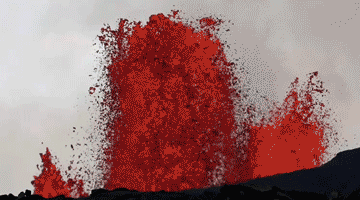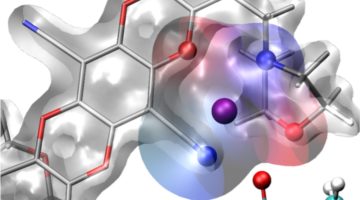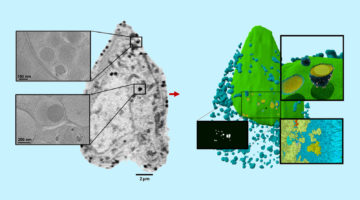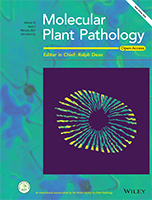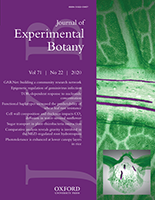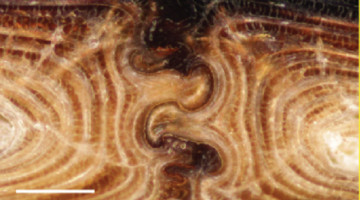Compared to the violent explosions of Mount Vesuvius or Mount St. Helens, Hawaiian volcanic eruptions are relatively calm, characterized by flowing rivers and fountains of lava. Here, researchers have discovered that even low-viscosity magma sometimes behaves more like brittle glass that shatters into fine particles. Read more »
ALS Work Using Tomography
Tomography allows 3D imaging of structures inside samples without the need to physically slice them open. A series of images is collected as a sample is rotated, and the raw data is computationally converted into digital sections that can be stacked to reconstruct 3D visualizations of the sample. The very high flux of x-rays and infrared light at the ALS allows collection of high-quality, high-speed 3D images at nanometer or micrometer resolution. Synchrotron tomography also enables photon-energy tuning for element- and chemistry-specific contrast, as well as phase-contrast imaging.
Designing Selective Membranes for Batteries Using a Drug Discovery Toolbox
Researchers designed a polymer membrane with molecular cages built into its pores that hold positively charged ions from a lithium salt. These “solvation cages” increased lithium-ion flow by an order of magnitude and could allow high-voltage battery cells to operate at higher power and more efficiently, important for both electric vehicles and aircraft. Read more »
3D Whole-Cell Mapping of Insulin Secretion
Researchers used soft x-ray tomography to gain a 3D whole-cell view of how insulin-producing pancreatic cells react upon exposure to glucose and a diabetes drug. The approach enables direct quantification of intracellular responses before, during, and after cell stimulation, providing new insights into how drugs alter cell function. Read more »![]()
![]()
A Detailed Look Inside Tsetse Flies
To better understand the unique reproductive biology of tsetse flies, which are carriers of the parasites that cause a deadly infection known as African sleeping sickness, researchers explored the intact organs and tissues of tsetse flies using a powerful 3D x-ray imaging technique at Berkeley Lab’s Advanced Light Source. Read more »
Xylella fastidiosa causes transcriptional shifts that precede tylose formation and starch depletion in xylem
During Pierce’s disease, Xylella fastidiosa triggers transcriptional changes in grapevines and induces major physiological responses, including tylose formation and starch depletion. X-ray computed microtomography and a machine-learning algorithm were used to track the depletion of starch reserves in the xylem of a grapevine stem infected with Pierce’s disease. Read more »
Unique X-Ray Microscope Reveals Dazzling 3D Cell Images
Researchers used soft x-ray tomography to reveal never-before-seen details about insulin secretion in pancreatic cells taken from rats. By quantifying subcellular rearrangements in response to drugs, the results are an important first step for bridging the longstanding gap between structural biology and physiology. Read more »
Coordinated decline of leaf hydraulic and stomatal conductances under drought is not linked to leaf xylem embolism for different grapevine cultivars
Drought decreases water transport capacity of leaves and limits gas exchange, which involves reduced leaf hydraulic conductance (Kleaf) in both the xylem and outside-xylem pathways. We combined Kleaf and gas exchange measurements, micro-computed tomography of intact leaves, and spatially explicit modeling of the outside-xylem pathways to evaluate the role of vein embolism and Kleaf in the responses of two different grapevine cultivars to drought. Read more »
Microstructures Explain Beetle Exoskeleton Strength
Using microtomography and other techniques, researchers identified the exoskeletal toughening mechanisms that explain the crush resistance of the aptly named diabolical ironclad beetle. The observations could be applied in developing tough, impact- and crush-resistant materials for joining dissimilar materials. Read more »![]()
![]()
X-Rays Reveal Architectural Clues to the Crush-Resistance of Diabolical Ironclad Beetles
The appropriately named diabolical ironclad beetle has an incredibly crush-resistant exoskeleton, which could serve as a blueprint for tougher materials. To see, in microscopic detail, what makes the beetle so uniquely ironclad, researchers used the ALS to explore a protective covering known as the “elytra,” its abdomen, and other parts. Read more »
Design and synthesis of high performance flexible and green supercapacitors made of manganese‐dioxide‐decorated alkali lignin
Researchers synthesized a plant‐based composite electrode for use in flexible supercapacitors and used synchrotron x‐ray microtomography to better understand the impact of microstructure and morphology on electrode porosity and electrical conductance. Read more »
- « Previous Page
- 1
- 2
- 3
- 4
- 5
- …
- 7
- Next Page »
